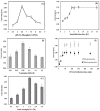An Ultrasensitive Voltammetric Genosensor for the Detection of Bacteria Vibrio cholerae in Vegetable and Environmental Water Samples
- PMID: 37366981
- PMCID: PMC10296214
- DOI: 10.3390/bios13060616
An Ultrasensitive Voltammetric Genosensor for the Detection of Bacteria Vibrio cholerae in Vegetable and Environmental Water Samples
Abstract
In view of the presence of pathogenic Vibrio cholerae (V. cholerae) bacteria in environmental waters, including drinking water, which may pose a potential health risk to humans, an ultrasensitive electrochemical DNA biosensor for rapid detection of V. cholerae DNA in the environmental sample was developed. Silica nanospheres were functionalized with 3-aminopropyltriethoxysilane (APTS) for effective immobilization of the capture probe, and gold nanoparticles were used for acceleration of electron transfer to the electrode surface. The aminated capture probe was immobilized onto the Si-Au nanocomposite-modified carbon screen printed electrode (Si-Au-SPE) via an imine covalent bond with glutaraldehyde (GA), which served as the bifunctional cross-linking agent. The targeted DNA sequence of V. cholerae was monitored via a sandwich DNA hybridization strategy with a pair of DNA probes, which included the capture probe and reporter probe that flanked the complementary DNA (cDNA), and evaluated by differential pulse voltammetry (DPV) in the presence of an anthraquninone redox label. Under optimum sandwich hybridization conditions, the voltammetric genosensor could detect the targeted V. cholerae gene from 1.0 × 10-17-1.0 × 10-7 M cDNA with a limit of detection (LOD) of 1.25 × 10-18 M (i.e., 1.1513 × 10-13 µg/µL) and long-term stability of the DNA biosensor up to 55 days. The electrochemical DNA biosensor was capable of giving a reproducible DPV signal with a relative standard deviation (RSD) of <5.0% (n = 5). Satisfactory recoveries of V. cholerae cDNA concentration from different bacterial strains, river water, and cabbage samples were obtained between 96.5% and 101.6% with the proposed DNA sandwich biosensing procedure. The V. cholerae DNA concentrations determined by the sandwich-type electrochemical genosensor in the environmental samples were correlated to the number of bacterial colonies obtained from standard microbiological procedures (bacterial colony count reference method).
Keywords: DNA biosensor; Vibrio cholerae; gold nanoparticles; sandwich hybridization; silica nanospheres.
Conflict of interest statement
The authors declare no conflict of interest.
Figures









Similar articles
-
Electrochemical genosensor assay using lyophilized gold nanoparticles/latex microsphere label for detection of Vibrio cholerae.Talanta. 2015 Jul 1;139:167-73. doi: 10.1016/j.talanta.2015.02.054. Epub 2015 Mar 6. Talanta. 2015. PMID: 25882423
-
An ultrasensitive hollow-silica-based biosensor for pathogenic Escherichia coli DNA detection.Anal Bioanal Chem. 2018 Mar;410(9):2363-2375. doi: 10.1007/s00216-018-0893-1. Epub 2018 Mar 5. Anal Bioanal Chem. 2018. PMID: 29504083
-
Ultrasensitive Biosensor for the Detection of Vibrio cholerae DNA with Polystyrene-co-acrylic Acid Composite Nanospheres.Nanoscale Res Lett. 2017 Dec;12(1):474. doi: 10.1186/s11671-017-2236-0. Epub 2017 Aug 1. Nanoscale Res Lett. 2017. PMID: 28774152 Free PMC article.
-
Development of an advanced DNA biosensor for pathogenic Vibrio cholerae detection in real sample.Biosens Bioelectron. 2021 Sep 15;188:113338. doi: 10.1016/j.bios.2021.113338. Epub 2021 May 15. Biosens Bioelectron. 2021. PMID: 34030094
-
An electrochemical DNA biosensor fabricated from graphene decorated with graphitic nanospheres.Nanotechnology. 2020 Nov 27;31(48):485501. doi: 10.1088/1361-6528/abab2e. Nanotechnology. 2020. PMID: 32748805
Cited by
-
Bioelectrochemical biosensors for water quality assessment and wastewater monitoring.Open Life Sci. 2024 Aug 23;19(1):20220933. doi: 10.1515/biol-2022-0933. eCollection 2024. Open Life Sci. 2024. PMID: 39220594 Free PMC article. Review.
References
-
- Luvhimbi N., Tshitangano T.G., Mabunda J.T., Olaniyi F.C., Edokpayi J.N. Water quality assessment and evaluation of human health risk of drinking water from source to point of use at Thulamela municipality, Limpopo Province. Sci. Rep. 2022;12:6059. doi: 10.1038/s41598-022-10092-4. - DOI - PMC - PubMed
-
- Ho J.Y., Lavinya A.A., Kay D.S.W., Lee C.I.S., Razmi A.H., Walsh C.L., Goodson M.L., Eswaran J. Towards an integrated approach to improve the understanding of the relationships between water-borne infections and health outcomes: Using Malaysia as a detailed case study. Front. Water. 2022;4:779860. doi: 10.3389/frwa.2022.779860. - DOI
MeSH terms
Substances
LinkOut - more resources
Full Text Sources

